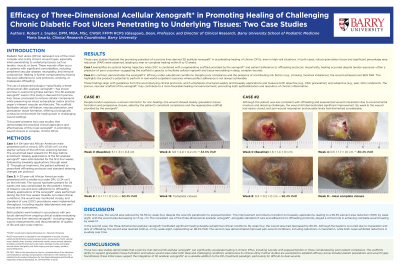Case Series/Study
(CS-150) Efficacy of Three-dimensional Acellular Xenograft* in Promoting Healing of Challenging Chronic Diabetic Foot Ulcers Penetrating to Underlying Tissues: Two Case Studies

Methods:
The first case involved a 64-year-old African American male with a chronic DFU (15.81 sq. cm) penetrating to underlying tissues, including exposed tendon, on the left foot. The wound, present for 55 days, was treated with weekly three-dimensional acellular xenograft* applications for four weeks, transitioning to biweekly applications. Offloading protocols were maintained throughout treatment.
The second case featured a 33-year-old African American male with a 24-week-old DFU (2.24 sq. cm) on the left heel. Challenges included tobacco use and non-adherence to offloading. The three-dimensional acellular xenograft* was applied weekly for the first four weeks.
Standard of care, including peri-wound assessments and dressing changes, was maintained. Wound progression was monitored weekly, focusing on changes in length, width, and depth.
Results:
In the first case, the wound area reduced by 75.7% by week four, despite the wound’s penetration to exposed tendon. This improvement prompted a transition to biweekly applications, leading to a 93.7% percent area reduction (PAR) by week eight, with the wound area decreasing to 1.0 sq. cm. The consistent use of the three-dimensional acellular xenograft*, alongside standard of care and adherence to offloading protocols, played a critical role in achieving substantial wound healing.
In the second case, the three-dimensional acellular xenograft* facilitated significant healing despite suboptimal clinical conditions. By week four, the wound area had decreased by 80.4%. Although fluctuations occurred due to maceration and lack of offloading, the wound area reached 0.24 sq. cm by week seven, representing an 89.3% PAR. This second case demonstrated improved peri-wound conditions, including reductions in maceration, while both cases exhibited reductions in exudate over time.
Discussion: These case studies demonstrate the three-dimensional acellular xenograft’s* ability to achieve substantial healing in chronic DFUs, even with underlying tissue involvement or challenging conditions. The first case underscored the importance of protocol adherence, while the second showcased the three-dimensional acellular xenograft’s* effectiveness under less-than-ideal scenarios. These findings highlight its versatility and effectiveness in managing complex wounds. Further research is needed to validate and optimize its clinical application.

.jpg)